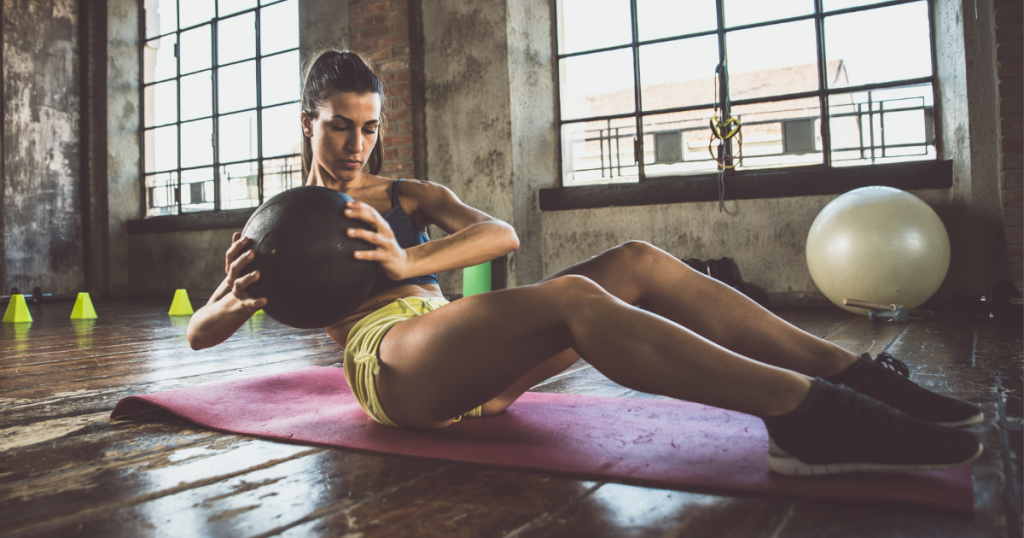Functional training: what is it and what are the benefits?

In the last decade, the awareness of planning correct physical preparation has increased dramatically, whether for athletic performance or personal well-being. From here comes the need to approach training in a “functional” manner, focusing on each person’s specific needs, goals and features.
So, what exactly does functional training consist of? Which exercises can be part of our programme? Can it be done autonomously or do we need specific equipment?
In this article, our trainers and physiotherapists explain how to organise basic functional training and, specifically, why we should be wary of pre-set courses and programmes.
What does “functional training” mean? Definition
Very often, non-experts -and unfortunately even some experts- identify functional training with the “Functional Fitness” courses that have been so fashionable in recent years. These activities propose very intensive sessions, training all muscle groups, mixing various types of exercises with various equipment: jumping on boxes, skipping, kettlebells, arm bends, rope climbing, etc., all done in a training circuit.
But are these two types of functional training the same thing? Yes and no, it depends on the purpose. To understand if training is truly functional, the main aspect to consider is the individual goal, because functional training should not merely focus on losing weight or burning calories.
Functional training is when the training is specific and guided in the right direction, whether to improve the physical performance of an athlete, achieve the correct body mass index in a person with a sedentary lifestyle who has to lose weight, or to recover efficiency in a part of the body that has suffered a trauma.
In other words, training is considered functional if it is effective and suited to our physical type, otherwise we risk simply making a lot of effort without reaching the goals we hoped for, as if, for example, we work hard to climb a mountain and when we get to the top, we realise we have taken the wrong path and climbed to the opposite peak.
What does a functional training programme consist of?
Anyone wishing to start a functional training programme must be supported and guided in every step by a professional or, even better, a team of professionals (athletic trainer, physiotherapist, nutritionist, etc.) able to develop a complete, targeted programme in all respects.
A correct functional training programme is developed in a number of phases:
- Individual case history: to analyse the sporting background and any prior accidents or illnesses.
- Definition of goals, whether short-, medium- or long-term, in terms of performance, accident prevention and improvement of personal well-being.
- Motor assessment: an in-depth analysis of correct posture, joint mobility and the stability of various parts of the body, neuro-muscular coordination and motor control.
- Athletic assessment: includes an analysis of the initial physical form and level of athletic preparation, with specific tests for cardiovascular and muscular strength.
- Any sport-specific tests for professional athletes or even amateur sportspersons wishing to improve their performance or prepare for competitions.
Of course, the case history is an essential point, as it allows the trainer to understand if the person is ready to undertake a functional training programme and if the intervention of a health specialist – such as a physiotherapist – is required for a more in-depth assessment of any muscular or skeletal problems. Furthermore, if there are any significant clinical issues, it is worth consulting a physician.
Having overcome any physical problems and having defined the goals, it is possible to start work, starting from the foundations, i.e., the posture and the quality of the basic motor coordination. It is important to ensure that the bases are solid, in order to avoid developing a programme and athletic performance based on unsuitable foundations, as this would increase the risk of injuries.
Depending on the results of the motor assessments, we can start to build an authentically tailored functional training programme: the personal trainer will include specific mobility and stabilisation routines in the training to prepare the person for the second phase, the actual session, concluded with a correct cool-down customised to suite the individual needs.
The assessment of the athletic condition leads to the next step to be analysed, but, unless there are particular criticalities, physical training can go hand in hand with the improvement of posture and individual joint limitations.
The athletic programme in functional training includes the improvement of conditional capacities, such as aerobic and muscular resistance and various aspects of strength. These capacities can be improved, on different levels and exercises, at all ages and all physical conditions. It depends on the experience, skill and creativity of the trainer to choose the most suitable exercises and methods for each individual. Remember that the same functional programme for two very similar people will not necessarily assure the same results, so progress has to be constantly monitored.
In the case of professional athletes or amateur sportspersons, the programme should also include a sport-specific functional training, consisting of exercises aiming to improve some athletic expressions that are competition-specific.
Customisation of the Functional Training programme: example
Now let’s see how a customised functional training programme can be designs to the specific needs of an amateur sportsperson. The following table provides information on the initial case history and functional and athletic assessments.
| Person: Amateur athlete (35 years old) |
| Sport: Tennis |
| Goals: improvement of sport-specific athletic conditions. |
| Case history: recurrent shoulder pain. Lesion to the left thigh femoral bicep (3 years ago). Frequent back pain (sedentary job). Mild hyperkyphosis. Currently plays tennis 3-4 times a week with no athletic preparation. |
| Injury Prevention: insufficient ankle mobility. Insufficient left femoral biceps flexibility. In general, mobility of various parts of the body could be improved. |
| Athletic Performance: sufficient cardiovascular strength. Low general and sport-specific strength. |
The above is the current overview of the main characteristics and aspects emerging from the athletic and postural assessments. The first step is to improve the quality of body use, setting a joint mobility and injury prevention routine to perform before physical and tennis training, consisting of:
- Myofascial release;
- General warm-up exercises;
- General mobility exercises focusing on the lumbar and thoracic areas;
- Specific mobility for the ankle and rear left thigh muscles;
- Rotator cuff muscle strengthening;
- Core stability.
At this point, the programme of exercises can begin; within a few weeks the first progress will be seen in the target areas, with a gradual reduction of the risk of injury and pain.
As regards the improvement of performance, in a programme like the one illustrated, we can include 2 athletic training sessions a week, avoiding excessive overload, also due to work commitments.
The central part of the functional training shall also include a phase devoted to developing strength. Preferably, the exercises should be multi-joint using weights, overloads and free body, including squats, deadlifts, bench presses, pull-ups, lunges, etc. including more complex variants or facilitations, depending on the level. General athletic exercises should follow, working on coordination and strength.
Remember that the whole programme is designed considering the general conditions of the individual, therefore adapting the exercises that they cannot do correctly. The programme must be followed with constant progression, both in terms of volume, intensity, density and difficulty. At the start of a functional training programme, sport-specific exercises should be delayed until the correct bases are obtained.
The final part of the training includes muscle stretching exercises, to be repeated, mainly on the posterior chain and the most frequently used muscle groups.
To conclude…
The above is only one example of how a correct functional programme should be set; it must consider many aspects, which go way beyond the choice of exercises to propose during the session.
This is why functional training cannot be considered a home-made or do-it-yourself training programme. Does the training help to lose weight? Does the training increase muscle mass or strength? Maybe, if this is your goal and if, with your team of trainers you are able to establish a system of customised exercises which considers your body as a whole.
Enjoy your training!




